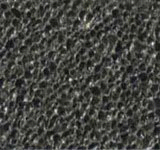
  |
Department:"Ecology and chemical technology"
Speciality:"Chemical technology of refractory non-metal and silicates materials"
Subject of diploma work:
Choice of foammaker and technological scheme for production of foamglas
The scientific supervisor : Ph.D. Associate Professor Bilomerya Nickolay Yosiphovich
Abstract
Foamglas was invented by the Soviet academician I.I. Kitajgorodskij in 1930. But it wasnít widely spread at that time and technology of production was almost lost in 90th. In the USA and Europe technology of production Foamglas has been kept. Foamglas is a material, consisting of hermetical cells. This structure of material excludes interaction of gas surrounding cells with atmosphere and leads to invariable characteristics of materials in time.
Foamglas is a bad conductor, thanks to its structure (for comparison: 5 cm of Foamglas can substitute 0.5 m thickness brick laying). Foamglas is the most effective insulation material of all. Compressive strength of foamglas is several times higher than that of fibrous materials and foamplastic. Thanks to the celled structure of foamglas, this material is resistant to shrinkage and doesnít change its sizes in time under the influence of building construction weight.
Foamglas is very light and its density is 140-200 kg/m3. It has small thermal expansion, which allows it to remain invariable under the influence of day and year temperature fluctuations.
Foamglas is the non-combustable and heatproof material. When heated to high temperature it only melts as ordinary glass without emitting gases or steams. This factor is very important for anti-fire properties of construction.
Foamglas doesnít change its chemical and physical properties in time that is why the guaranteed period of exploitation is morethan 100 years. It doesnít absorb and pass water. That is very important for keeping insulation properties. Foamglas is resistant towards chemical substances (except hydrofluoric acid) and rot, vermin, rodents. It is completely ecologically safe.

Technology of production consists of the following stages recycled, mechanically cleaned glass is milled together with foammaker in the ball mill to the powder; the mixture is loaded into steel moulds, which are coated with kaolin. Moulds go into tunnel furnace on trucks or on roller conveyor. Particles of glass soften and fuse together at high temperature. The gases, forming from interaction of foammaker with components of glass, froth viscous mass of glass. The temperature of this process for different foammakers varies from 5500C to 9000C. While cooling the material with cell structure appears. Slow cooling provides uniform cooling the whole of products that is why inside stresses donít occur and cracks arenít formed. The process of frothing itself is very difficult technological operation, this very process the focus of our research. We have carried out some experiments with used milled coke, baked soot and active soot as foammeker. Using active soot has showed very interesting results - 0.1% foammaker is sufficient for frothing, getting the closed shape cells, which completely donít pass water. These results were obtained using milled coke, but cells had big dimensions, and we used from 1% to 3% of coke. Variety of using window and bottle-reused glass (colored and transparent) gave identical results. That is why we have come to the conclusion that it is not important which composition of reused glass we use. Working out more precise composition of mix using an active soot and studying of the temperature mode are our following tasks.
The application of foamglas, is very various and stipulates for unique properties of foamlass. Mainly it is used as insulation in civil building, for creation of fire-preventive construction, for insulation of pipeline and other equipment, which work at high temperature to 5000C. Rot proof, resistance to rodents, vermin and insect are very important for using of foamglas in closed unventilated space. Using of foamglas allows to save up to 25% during building up to 30% on heating of building.
Water vapor permeability of foamglas is less than 5%, what allows using it as insulation in wet environment. Ecological and sanitary safety of foamglas allows carrying out warming of guarded construction for lodging; requiring higher cleanliness of air (school and hospital buildings, high technology manufacturing and etc) and building with special sanitary-hygienic requirements (food and farm industries; bath-houses and swimming pools). Depending on the recipe and technology of foamglas manufacturing it can have closed and opened structure that is why it is used as effective filter and even as defense from dangerous electro-magnetic radiation.
Foamglas is also used for manufacturing of chemical reactors, building of reservoirs and pipelines for acids and oil products, because it is resistant towards chemical substances.
Production and using of foamglas is very important from the ecological point of view, because, in this technology the recycled glass or glass, made of low quality sand are use.
Wastes of foamglas manufacturing donít pollute environment and are use as abrasive material, which doesnít change its properties in process of using.
Industrial manufacturing of foamglas exists in USA, Japan, China, Belgium, German, but unfortunately it doesnít exist in Ukraine. We hope that our research will help to perfect technology of production of foamglas in Ukraine.